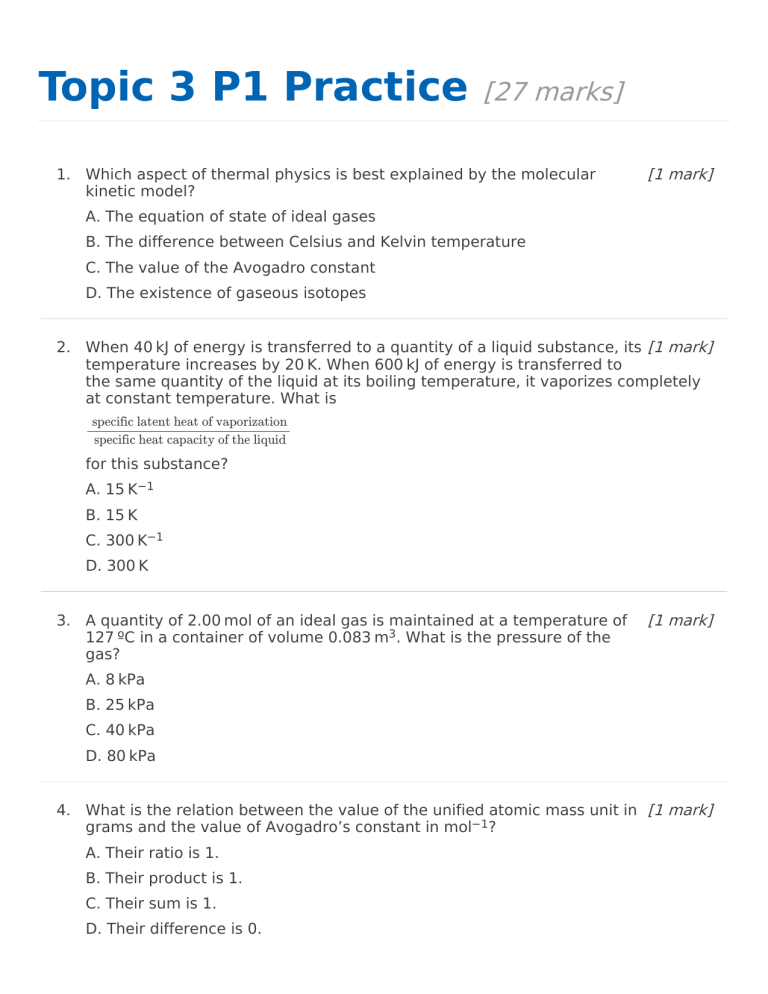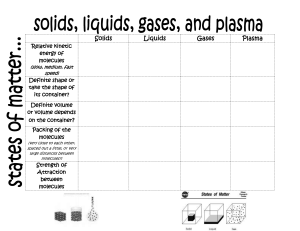
Topic 3 P1 Practice [27 marks] 1. Which aspect of thermal physics is best explained by the molecular kinetic model? [1 mark] A. The equation of state of ideal gases B. The difference between Celsius and Kelvin temperature C. The value of the Avogadro constant D. The existence of gaseous isotopes 2. When 40 kJ of energy is transferred to a quantity of a liquid substance, its [1 mark] temperature increases by 20 K. When 600 kJ of energy is transferred to the same quantity of the liquid at its boiling temperature, it vaporizes completely at constant temperature. What is specific latent heat of vaporization specific heat capacity of the liquid for this substance? A. 15 K−1 B. 15 K C. 300 K−1 D. 300 K 3. A quantity of 2.00 mol of an ideal gas is maintained at a temperature of 127 ºC in a container of volume 0.083 m3. What is the pressure of the gas? [1 mark] A. 8 kPa B. 25 kPa C. 40 kPa D. 80 kPa 4. What is the relation between the value of the unified atomic mass unit in [1 mark] grams and the value of Avogadro’s constant in mol−1? A. Their ratio is 1. B. Their product is 1. C. Their sum is 1. D. Their difference is 0. 3 5. A sample of oxygen gas with a volume of 3. 0 m 3 is at 100 °C. The gas is [1 mark] heated so that it expands at a constant pressure to a final volume of 6. 0 m3 . What is the final temperature of the gas? 750 °C B. 470 °C C. 370 °C D. 200 °C A. 6. Two identical containers X and Y each contain an ideal gas. X has N [1 mark] molecules of gas at an absolute temperature of T and Y has 3N molecules P of gas at an absolute temperature of T2 What is the ratio of the pressures Y ? PX A. 16 B. 23 C. 32 D. 6 7. A piece of metal at a temperature of 100 °C is dropped into an equal [1 mark] mass of water at a temperature of 15 °C in a container of negligible mass. The specific heat capacity of water is four times that of the metal. What is the final temperature of the mixture? 83 °C B. 57 °C C. 45 °C D. 32 °C A. 8. Two ideal gases X and Y are at the same temperature. The mass of a [1 mark] particle of gas X is larger than the mass of a particle of gas Y. Which is correct about the average kinetic energy and the average speed of the particles in gases X and Y? 9. An ideal gas of constant mass is heated in a container of constant volume. [1 mark] What is the reason for the increase in pressure of the gas? A. The average number of molecules per unit volume increases. B. The average force per impact at the container wall increases. C. Molecules collide with each other more frequently. D. Molecules occupy a greater fractional volume of the container. 10. A substance in the gas state has a density about 1000 times less than [1 mark] when it is in the liquid state. The diameter of a molecule is d. What is the best estimate of the average distance between molecules in the gas state? A. d B. 10d C. 100d D. 1000d 11. A bicycle of mass M comes to rest from speed v using the back brake. The brake has a specific heat capacity of c and a mass m . Half of the kinetic energy is absorbed by the brake. What is the change in temperature of the brake? v2 A. M 4 mc v2 B. M 2 mc 2 C. 4mv Mc 2 D. 2mv Mc [1 mark] 12. What is not an assumption of the kinetic model of an ideal gas? [1 mark] A. Attractive forces between molecules are negligible. B. Collision duration is negligible compared with time between collisions. C. Molecules suffer negligible momentum change during wall collisions. D. Molecular volume is negligible compared with gas volume. 13. Two containers X and Y are maintained at the same temperature. X has [1 mark] volume 4 m3 and Y has volume 6 m 3 . They both hold an ideal gas. The pressure in X is 100 Pa and the pressure in Y is 50 Pa. The containers are then joined by a tube of negligible volume. What is the final pressure in the containers? 70 Pa B. 75 Pa C. 80 Pa D. 150 Pa A. 14. An ideal gas is in a closed container. Which changes to its volume and temperature when taken together must cause a decrease in the gas pressure? [1 mark] 15. Two flasks P and Q contain an ideal gas and are connected with a tube of [1 mark] negligible volume compared to that of the flasks. The volume of P is twice the volume of Q. P is held at a temperature of 200 K and Q is held at a temperature of 400 K. What is mass of mass of gas in P ? mass of gas in Q A. 18 B. 14 C. 4 D. 8 16. A mass m of water is at a temperature of 290 K. The specific heat [1 mark] capacity of water is c. Ice, at its melting point, is added to the water to reduce the water temperature to the freezing point. The specific latent heat of fusion for ice is L. What is the minimum mass of ice that is required? A. 17mc L 290mc B. L C. 17mL c D. 290cmL 17. An insulated tube is filled with a large number n of lead spheres, each of [1 mark] mass m . The tube is inverted s times so that the spheres completely fall through an average distance L each time. The temperature of the spheres is measured before and after the inversions and the resultant change in temperature is ΔT. What is the specific heat capacity of lead? sgL nmΔ T A. B. sgL ΔT C. sgL nΔT D. gL mΔT 18. An ideal gas and a solid of the same substance are at the same [1 mark] temperature. The average kinetic energy of the gas molecules is Eg and the average kinetic energy of the solid molecules is Es . What is the comparison between Eg and Eg ? A. C. Eg is less than Es . Eg equals Es . Eg is greater than Es . D. The relationship between Eg and B. Es cannot be determined. 19. A thin-walled cylinder of weight W, open at both ends, rests on a flat [1 mark] surface. The cylinder has a height L, an average radius R and a thickness x where R is much greater than x. What is the pressure exerted by the cylinder walls on the flat surface? A. 2 W πR x W π R 2x C. W 2 πR B. D. W R π 2L 20. The graph shows the variation with time t of the temperature T of two [1 mark] samples, X and Y. X and Y have the same mass and are initially in the solid phase. Thermal energy is being provided to X and Y at the same constant rate. What is the correct comparison of the specific latent heats LX and LY and specific heat capacities in the liquid phase cX and cY of X and Y? 21. A mass m of ice at a temperature of –5 °C is changed into water at a temperature of 50 °C. [1 mark] Specific heat capacity of ice = ci Specific heat capacity of water = cw Specific latent heat of fusion of ice = L Which expression gives the energy needed for this change to occur? A. 55 m c w + m L B. 55 m c i + 5 m L C. 5 m c i + 50 m c w + m L D. 5 m c i + 50 m c w + 5 m L 22. A sealed container contains a mixture of oxygen and nitrogen gas. mass of an oxygen molecule The ratio is 87 . mass of a nitrogen molecule The ratio [1 mark] average kinetic energy of oxygen molecules is average kinetic energy of nitrogen molecules A. 1. B. 78 . C. 87 . D. dependent on the concentration of each gas. 23. An ideal gas has a volume of 15 ml, a temperature of 20 °C and a pressure of 100 kPa. The volume of the gas is reduced to 5 ml and the temperature is raised to 40 °C. What is the new pressure of the gas? A. 600 kPa B. 320 kPa C. 200 kPa D. 35 kPa [1 mark] 24. Energy is supplied at a constant rate to a fixed mass of a material. The material begins as a solid. The graph shows the variation of the temperature of the material with time. [1 mark] The specific heat capacities of the solid, liquid and gaseous forms of the material are cs cl and cg respectively. What can be deduced about the values of cs cl and cg ? A. cs > cg > cl B. cl > cs > cg C. cl > cg > cs D. cg > cs > cl 25. An ideal gas of N molecules is maintained at a constant pressure p. The graph shows how the volume V of the gas varies with absolute temperature T. What is the gradient of the graph? A. N p B. NpR C. NkB p N D. Rp [1 mark] 26. The pressure of a fixed mass of an ideal gas in a container is decreased at[1 mark] constant temperature. For the molecules of the gas there will be a decrease in A. the mean square speed. B. the number striking the container walls every second. C. the force between them. D. their diameter. 27. A substance is heated at constant power. The graph shows how the temperature T of the substance varies with time t as the state of the substance changes from liquid to gas. [1 mark] What can be determined from the graph? A. The specific heat capacity of the gas is smaller than the specific heat capacity of the liquid. B. The specific heat capacity of the gas is larger than the specific heat capacity of the liquid. C. The specific latent heat of fusion of the substance is less than its specific latent heat of vaporization. D. The specific latent heat of fusion of the substance is larger than its specific latent heat of vaporization. © International Baccalaureate Organization 2021 International Baccalaureate® - Baccalauréat International® - Bachillerato Internacional® Printed for CONCORDIAN INTL SCH THAILAND


